Critical Essay: Seralini Study, Peer Review, and Public Communication
VerifiedAdded on 2023/01/18
|7
|2342
|33
Essay
AI Summary
This essay critically analyzes the Seralini study, which investigated the long-term toxicity of Roundup-tolerant genetically modified maize and the herbicide Roundup on rats. The study's findings, including increased tumor development and mortality in treated groups, sparked significant controversy and were initially published in Food and Chemical Toxicology, but later retracted due to methodological flaws and criticism. The essay examines the scientific arguments surrounding the case, the peer review process, and the subsequent retraction and republication of the study in Environmental Sciences Europe. It compares how the study's results were communicated to the public versus the scientific publications, highlighting the role of peer review, science communication, and the ethical considerations involved in disseminating scientific findings. The essay also discusses the impact of this case on biotechnology advocacy and the importance of rigorous peer review in maintaining the integrity of scientific literature.
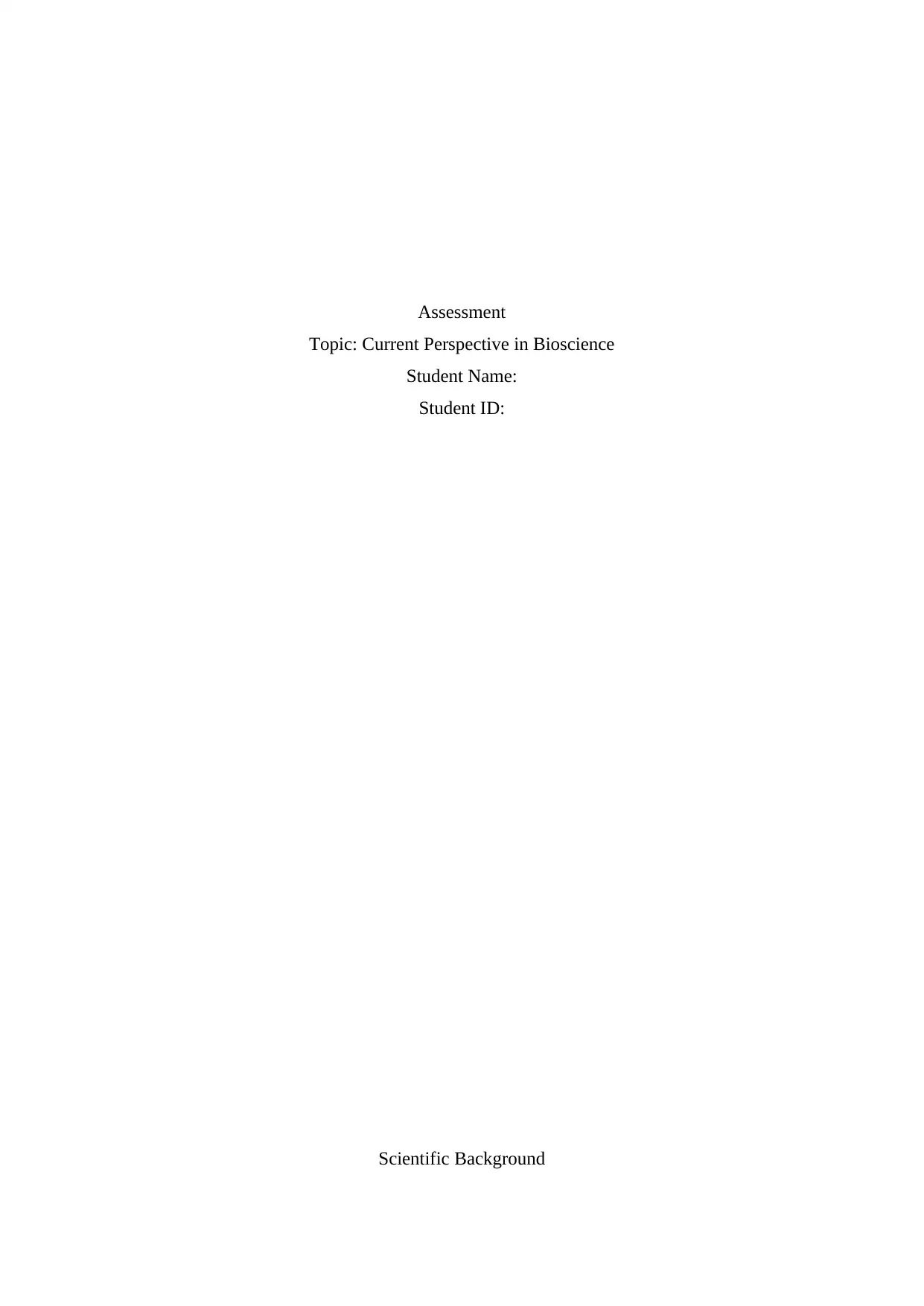
Assessment
Topic: Current Perspective in Bioscience
Student Name:
Student ID:
Scientific Background
Topic: Current Perspective in Bioscience
Student Name:
Student ID:
Scientific Background
Paraphrase This Document
Need a fresh take? Get an instant paraphrase of this document with our AI Paraphraser

Current Perspective in Bioscience 2
The toxicity and adverse health effects of round up tolerant genetically modified maize over
the rats was studied for two years. The impact was that in all the female rats and 3 male
groups of rats, all the treated groups had died 2-3 times greater and faster than the control
groups. The results were all sex and hormone dependent. Females developed tumors,
pituitary gland was diabled, the balance of seex hormones was disturbed and liver
congestionas and necrosis was common in these groups. There were significant endocrine
disrupting effect of the round up herbicide. Also the chronic diet intoxication and
overexpression of transgene in GMO resulted in adverse metabolic consequences on the rats
possibly due to pesticide residues in GM feed.
In 2012, this article was published in Journal “Food and Chemical Toxicology” and had
claimed that the rats used in the research were fed over roundup resistant genetically
modified maize, GM maize having round up for a period of two years (Resnik, 2015). The
rats got high number of tumors, liver and kidney damage than the controls. This study was
severly criticised by several scientists and researchers for flaws and unethical practice. In
2014, January month the jurnal retracted the article without getting author’s consent giving
the erason that the study was non conclusive. In 2014, June month the Environmental
Sciences Europe republished the article in modified form (Resnik, 2015). This incident of
publication, retraction and republication of Seralini Study initiated many ethical and scientific
concerns about the editors of the journals.
The decisions about retraction of any article need to be taken on the grounds of authentic
policies. Retraction should be done only for the serious issues which diminish the reliability
of results or data or for unethical practices like mistreatment of subjects, animals or human
beings and misconduct in research. Just indecisiveness and inconclusiveness does not provide
sufficient grounds for the article for retraction. A defective study design can ofcourse be one
reason for that. There should be appropriate standards for each published article to qualify for
republication. They should undergo scientific review to ensure that. The republished articles
need to be associetd to the retracted original publications. The journals reviewing the
published articles for their social and scientific implications must ensure a fair and rigrous
peer review.
The article was dismissed by the scientific community and a more intense peer review
process was demanded in scientific journals. The conclusions of teh article were unjustifiable.
The rats used in the study had the lifespan of just two years and the strain had high risk of
developing tumors or cancer. It is natural for this tsrain that with increasing age, they were
more vulnerable to get cancerous tumors. The study just involved the normal lifespan of these
The toxicity and adverse health effects of round up tolerant genetically modified maize over
the rats was studied for two years. The impact was that in all the female rats and 3 male
groups of rats, all the treated groups had died 2-3 times greater and faster than the control
groups. The results were all sex and hormone dependent. Females developed tumors,
pituitary gland was diabled, the balance of seex hormones was disturbed and liver
congestionas and necrosis was common in these groups. There were significant endocrine
disrupting effect of the round up herbicide. Also the chronic diet intoxication and
overexpression of transgene in GMO resulted in adverse metabolic consequences on the rats
possibly due to pesticide residues in GM feed.
In 2012, this article was published in Journal “Food and Chemical Toxicology” and had
claimed that the rats used in the research were fed over roundup resistant genetically
modified maize, GM maize having round up for a period of two years (Resnik, 2015). The
rats got high number of tumors, liver and kidney damage than the controls. This study was
severly criticised by several scientists and researchers for flaws and unethical practice. In
2014, January month the jurnal retracted the article without getting author’s consent giving
the erason that the study was non conclusive. In 2014, June month the Environmental
Sciences Europe republished the article in modified form (Resnik, 2015). This incident of
publication, retraction and republication of Seralini Study initiated many ethical and scientific
concerns about the editors of the journals.
The decisions about retraction of any article need to be taken on the grounds of authentic
policies. Retraction should be done only for the serious issues which diminish the reliability
of results or data or for unethical practices like mistreatment of subjects, animals or human
beings and misconduct in research. Just indecisiveness and inconclusiveness does not provide
sufficient grounds for the article for retraction. A defective study design can ofcourse be one
reason for that. There should be appropriate standards for each published article to qualify for
republication. They should undergo scientific review to ensure that. The republished articles
need to be associetd to the retracted original publications. The journals reviewing the
published articles for their social and scientific implications must ensure a fair and rigrous
peer review.
The article was dismissed by the scientific community and a more intense peer review
process was demanded in scientific journals. The conclusions of teh article were unjustifiable.
The rats used in the study had the lifespan of just two years and the strain had high risk of
developing tumors or cancer. It is natural for this tsrain that with increasing age, they were
more vulnerable to get cancerous tumors. The study just involved the normal lifespan of these
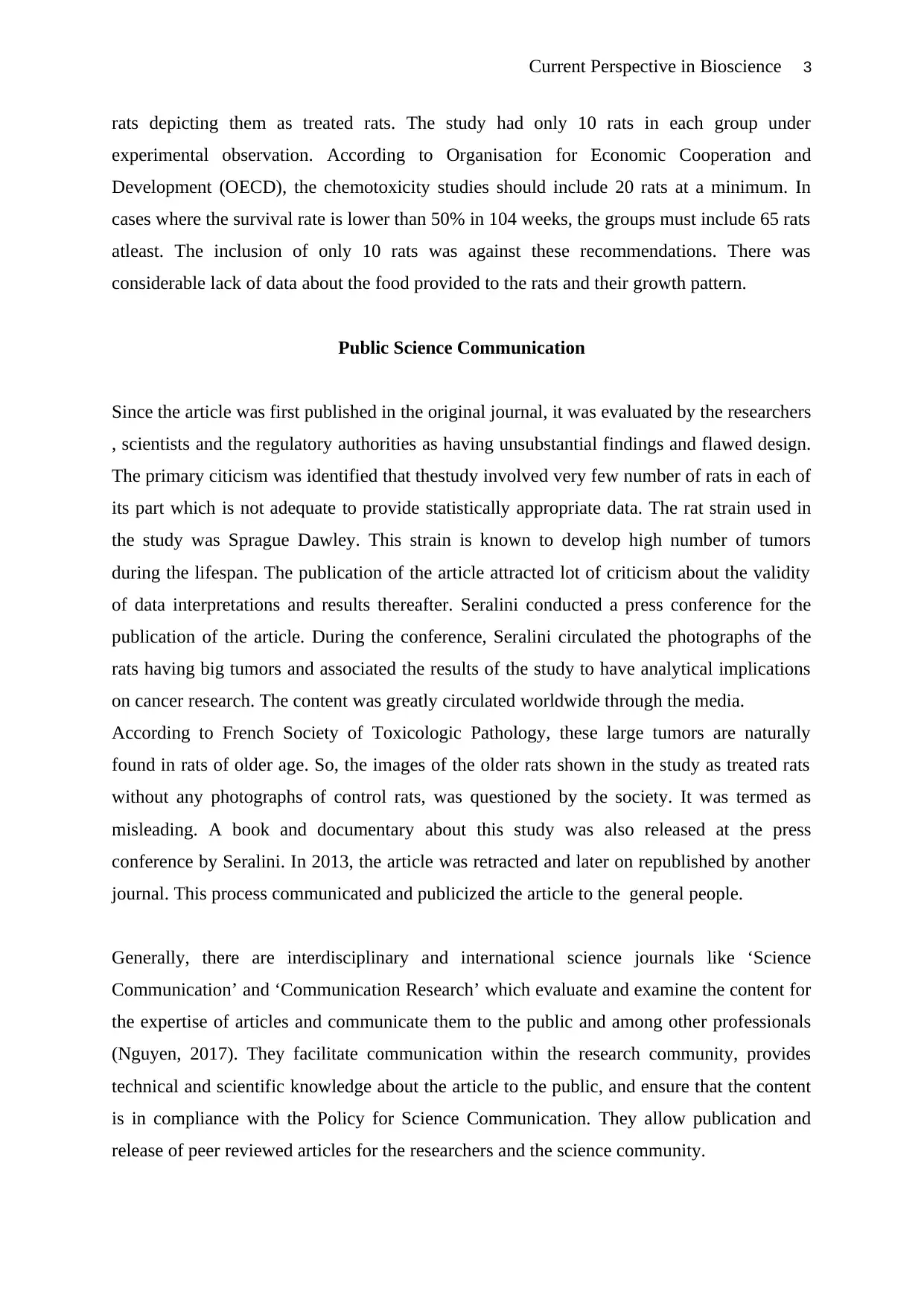
Current Perspective in Bioscience 3
rats depicting them as treated rats. The study had only 10 rats in each group under
experimental observation. According to Organisation for Economic Cooperation and
Development (OECD), the chemotoxicity studies should include 20 rats at a minimum. In
cases where the survival rate is lower than 50% in 104 weeks, the groups must include 65 rats
atleast. The inclusion of only 10 rats was against these recommendations. There was
considerable lack of data about the food provided to the rats and their growth pattern.
Public Science Communication
Since the article was first published in the original journal, it was evaluated by the researchers
, scientists and the regulatory authorities as having unsubstantial findings and flawed design.
The primary citicism was identified that thestudy involved very few number of rats in each of
its part which is not adequate to provide statistically appropriate data. The rat strain used in
the study was Sprague Dawley. This strain is known to develop high number of tumors
during the lifespan. The publication of the article attracted lot of criticism about the validity
of data interpretations and results thereafter. Seralini conducted a press conference for the
publication of the article. During the conference, Seralini circulated the photographs of the
rats having big tumors and associated the results of the study to have analytical implications
on cancer research. The content was greatly circulated worldwide through the media.
According to French Society of Toxicologic Pathology, these large tumors are naturally
found in rats of older age. So, the images of the older rats shown in the study as treated rats
without any photographs of control rats, was questioned by the society. It was termed as
misleading. A book and documentary about this study was also released at the press
conference by Seralini. In 2013, the article was retracted and later on republished by another
journal. This process communicated and publicized the article to the general people.
Generally, there are interdisciplinary and international science journals like ‘Science
Communication’ and ‘Communication Research’ which evaluate and examine the content for
the expertise of articles and communicate them to the public and among other professionals
(Nguyen, 2017). They facilitate communication within the research community, provides
technical and scientific knowledge about the article to the public, and ensure that the content
is in compliance with the Policy for Science Communication. They allow publication and
release of peer reviewed articles for the researchers and the science community.
rats depicting them as treated rats. The study had only 10 rats in each group under
experimental observation. According to Organisation for Economic Cooperation and
Development (OECD), the chemotoxicity studies should include 20 rats at a minimum. In
cases where the survival rate is lower than 50% in 104 weeks, the groups must include 65 rats
atleast. The inclusion of only 10 rats was against these recommendations. There was
considerable lack of data about the food provided to the rats and their growth pattern.
Public Science Communication
Since the article was first published in the original journal, it was evaluated by the researchers
, scientists and the regulatory authorities as having unsubstantial findings and flawed design.
The primary citicism was identified that thestudy involved very few number of rats in each of
its part which is not adequate to provide statistically appropriate data. The rat strain used in
the study was Sprague Dawley. This strain is known to develop high number of tumors
during the lifespan. The publication of the article attracted lot of criticism about the validity
of data interpretations and results thereafter. Seralini conducted a press conference for the
publication of the article. During the conference, Seralini circulated the photographs of the
rats having big tumors and associated the results of the study to have analytical implications
on cancer research. The content was greatly circulated worldwide through the media.
According to French Society of Toxicologic Pathology, these large tumors are naturally
found in rats of older age. So, the images of the older rats shown in the study as treated rats
without any photographs of control rats, was questioned by the society. It was termed as
misleading. A book and documentary about this study was also released at the press
conference by Seralini. In 2013, the article was retracted and later on republished by another
journal. This process communicated and publicized the article to the general people.
Generally, there are interdisciplinary and international science journals like ‘Science
Communication’ and ‘Communication Research’ which evaluate and examine the content for
the expertise of articles and communicate them to the public and among other professionals
(Nguyen, 2017). They facilitate communication within the research community, provides
technical and scientific knowledge about the article to the public, and ensure that the content
is in compliance with the Policy for Science Communication. They allow publication and
release of peer reviewed articles for the researchers and the science community.
You're viewing a preview
Unlock full access by subscribing today!
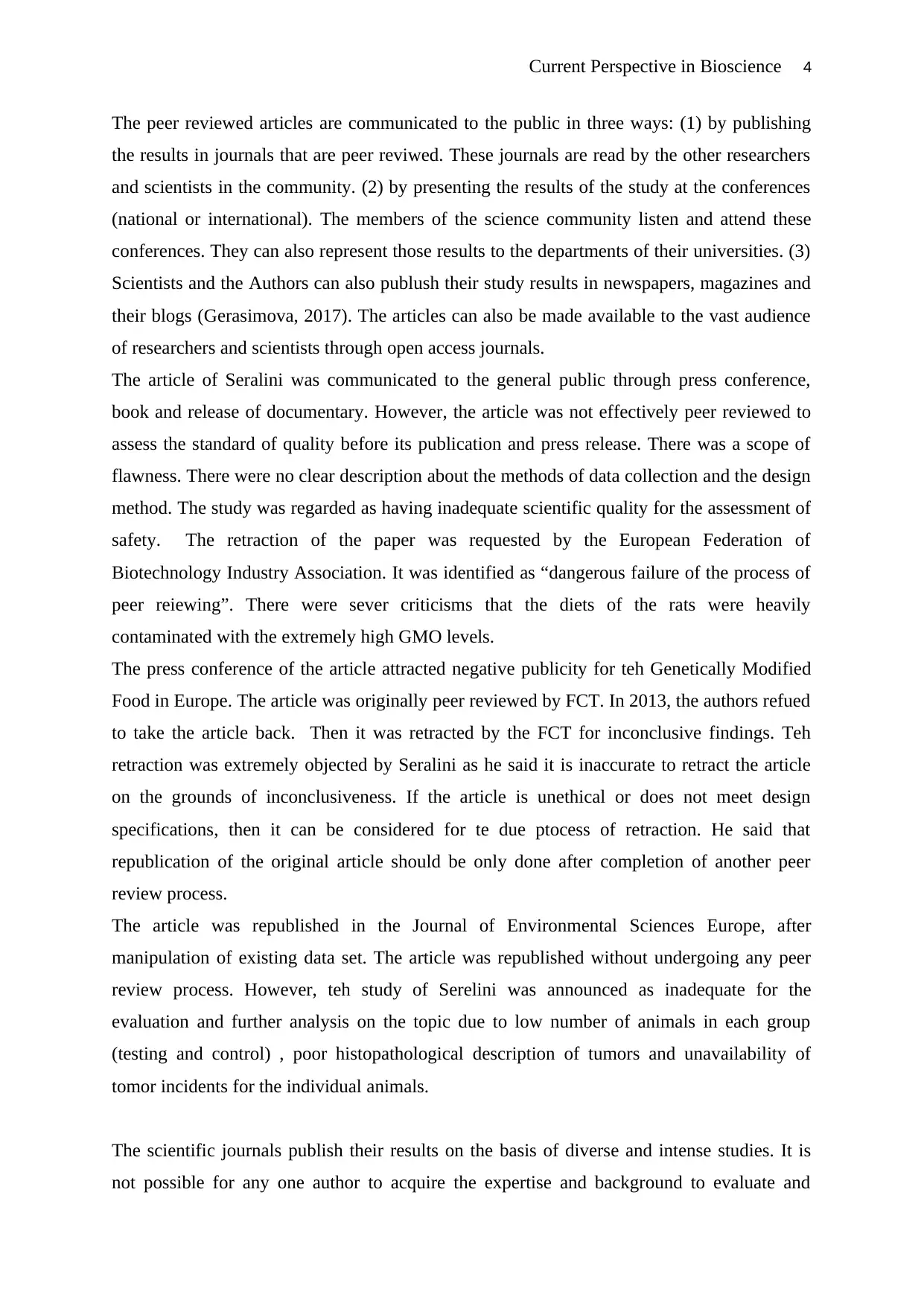
Current Perspective in Bioscience 4
The peer reviewed articles are communicated to the public in three ways: (1) by publishing
the results in journals that are peer reviwed. These journals are read by the other researchers
and scientists in the community. (2) by presenting the results of the study at the conferences
(national or international). The members of the science community listen and attend these
conferences. They can also represent those results to the departments of their universities. (3)
Scientists and the Authors can also publush their study results in newspapers, magazines and
their blogs (Gerasimova, 2017). The articles can also be made available to the vast audience
of researchers and scientists through open access journals.
The article of Seralini was communicated to the general public through press conference,
book and release of documentary. However, the article was not effectively peer reviewed to
assess the standard of quality before its publication and press release. There was a scope of
flawness. There were no clear description about the methods of data collection and the design
method. The study was regarded as having inadequate scientific quality for the assessment of
safety. The retraction of the paper was requested by the European Federation of
Biotechnology Industry Association. It was identified as “dangerous failure of the process of
peer reiewing”. There were sever criticisms that the diets of the rats were heavily
contaminated with the extremely high GMO levels.
The press conference of the article attracted negative publicity for teh Genetically Modified
Food in Europe. The article was originally peer reviewed by FCT. In 2013, the authors refued
to take the article back. Then it was retracted by the FCT for inconclusive findings. Teh
retraction was extremely objected by Seralini as he said it is inaccurate to retract the article
on the grounds of inconclusiveness. If the article is unethical or does not meet design
specifications, then it can be considered for te due ptocess of retraction. He said that
republication of the original article should be only done after completion of another peer
review process.
The article was republished in the Journal of Environmental Sciences Europe, after
manipulation of existing data set. The article was republished without undergoing any peer
review process. However, teh study of Serelini was announced as inadequate for the
evaluation and further analysis on the topic due to low number of animals in each group
(testing and control) , poor histopathological description of tumors and unavailability of
tomor incidents for the individual animals.
The scientific journals publish their results on the basis of diverse and intense studies. It is
not possible for any one author to acquire the expertise and background to evaluate and
The peer reviewed articles are communicated to the public in three ways: (1) by publishing
the results in journals that are peer reviwed. These journals are read by the other researchers
and scientists in the community. (2) by presenting the results of the study at the conferences
(national or international). The members of the science community listen and attend these
conferences. They can also represent those results to the departments of their universities. (3)
Scientists and the Authors can also publush their study results in newspapers, magazines and
their blogs (Gerasimova, 2017). The articles can also be made available to the vast audience
of researchers and scientists through open access journals.
The article of Seralini was communicated to the general public through press conference,
book and release of documentary. However, the article was not effectively peer reviewed to
assess the standard of quality before its publication and press release. There was a scope of
flawness. There were no clear description about the methods of data collection and the design
method. The study was regarded as having inadequate scientific quality for the assessment of
safety. The retraction of the paper was requested by the European Federation of
Biotechnology Industry Association. It was identified as “dangerous failure of the process of
peer reiewing”. There were sever criticisms that the diets of the rats were heavily
contaminated with the extremely high GMO levels.
The press conference of the article attracted negative publicity for teh Genetically Modified
Food in Europe. The article was originally peer reviewed by FCT. In 2013, the authors refued
to take the article back. Then it was retracted by the FCT for inconclusive findings. Teh
retraction was extremely objected by Seralini as he said it is inaccurate to retract the article
on the grounds of inconclusiveness. If the article is unethical or does not meet design
specifications, then it can be considered for te due ptocess of retraction. He said that
republication of the original article should be only done after completion of another peer
review process.
The article was republished in the Journal of Environmental Sciences Europe, after
manipulation of existing data set. The article was republished without undergoing any peer
review process. However, teh study of Serelini was announced as inadequate for the
evaluation and further analysis on the topic due to low number of animals in each group
(testing and control) , poor histopathological description of tumors and unavailability of
tomor incidents for the individual animals.
The scientific journals publish their results on the basis of diverse and intense studies. It is
not possible for any one author to acquire the expertise and background to evaluate and
Paraphrase This Document
Need a fresh take? Get an instant paraphrase of this document with our AI Paraphraser
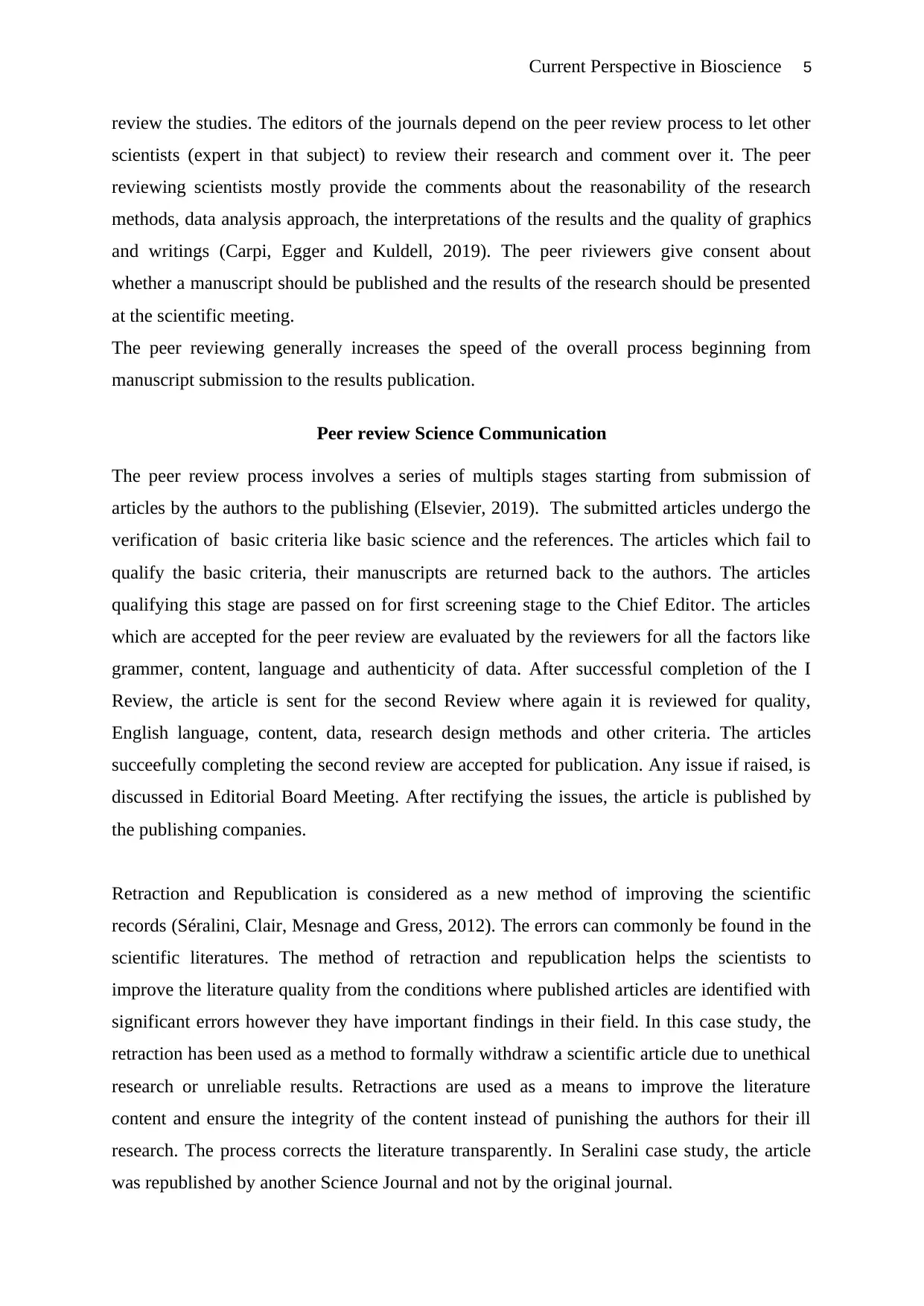
Current Perspective in Bioscience 5
review the studies. The editors of the journals depend on the peer review process to let other
scientists (expert in that subject) to review their research and comment over it. The peer
reviewing scientists mostly provide the comments about the reasonability of the research
methods, data analysis approach, the interpretations of the results and the quality of graphics
and writings (Carpi, Egger and Kuldell, 2019). The peer riviewers give consent about
whether a manuscript should be published and the results of the research should be presented
at the scientific meeting.
The peer reviewing generally increases the speed of the overall process beginning from
manuscript submission to the results publication.
Peer review Science Communication
The peer review process involves a series of multipls stages starting from submission of
articles by the authors to the publishing (Elsevier, 2019). The submitted articles undergo the
verification of basic criteria like basic science and the references. The articles which fail to
qualify the basic criteria, their manuscripts are returned back to the authors. The articles
qualifying this stage are passed on for first screening stage to the Chief Editor. The articles
which are accepted for the peer review are evaluated by the reviewers for all the factors like
grammer, content, language and authenticity of data. After successful completion of the I
Review, the article is sent for the second Review where again it is reviewed for quality,
English language, content, data, research design methods and other criteria. The articles
succeefully completing the second review are accepted for publication. Any issue if raised, is
discussed in Editorial Board Meeting. After rectifying the issues, the article is published by
the publishing companies.
Retraction and Republication is considered as a new method of improving the scientific
records (Séralini, Clair, Mesnage and Gress, 2012). The errors can commonly be found in the
scientific literatures. The method of retraction and republication helps the scientists to
improve the literature quality from the conditions where published articles are identified with
significant errors however they have important findings in their field. In this case study, the
retraction has been used as a method to formally withdraw a scientific article due to unethical
research or unreliable results. Retractions are used as a means to improve the literature
content and ensure the integrity of the content instead of punishing the authors for their ill
research. The process corrects the literature transparently. In Seralini case study, the article
was republished by another Science Journal and not by the original journal.
review the studies. The editors of the journals depend on the peer review process to let other
scientists (expert in that subject) to review their research and comment over it. The peer
reviewing scientists mostly provide the comments about the reasonability of the research
methods, data analysis approach, the interpretations of the results and the quality of graphics
and writings (Carpi, Egger and Kuldell, 2019). The peer riviewers give consent about
whether a manuscript should be published and the results of the research should be presented
at the scientific meeting.
The peer reviewing generally increases the speed of the overall process beginning from
manuscript submission to the results publication.
Peer review Science Communication
The peer review process involves a series of multipls stages starting from submission of
articles by the authors to the publishing (Elsevier, 2019). The submitted articles undergo the
verification of basic criteria like basic science and the references. The articles which fail to
qualify the basic criteria, their manuscripts are returned back to the authors. The articles
qualifying this stage are passed on for first screening stage to the Chief Editor. The articles
which are accepted for the peer review are evaluated by the reviewers for all the factors like
grammer, content, language and authenticity of data. After successful completion of the I
Review, the article is sent for the second Review where again it is reviewed for quality,
English language, content, data, research design methods and other criteria. The articles
succeefully completing the second review are accepted for publication. Any issue if raised, is
discussed in Editorial Board Meeting. After rectifying the issues, the article is published by
the publishing companies.
Retraction and Republication is considered as a new method of improving the scientific
records (Séralini, Clair, Mesnage and Gress, 2012). The errors can commonly be found in the
scientific literatures. The method of retraction and republication helps the scientists to
improve the literature quality from the conditions where published articles are identified with
significant errors however they have important findings in their field. In this case study, the
retraction has been used as a method to formally withdraw a scientific article due to unethical
research or unreliable results. Retractions are used as a means to improve the literature
content and ensure the integrity of the content instead of punishing the authors for their ill
research. The process corrects the literature transparently. In Seralini case study, the article
was republished by another Science Journal and not by the original journal.
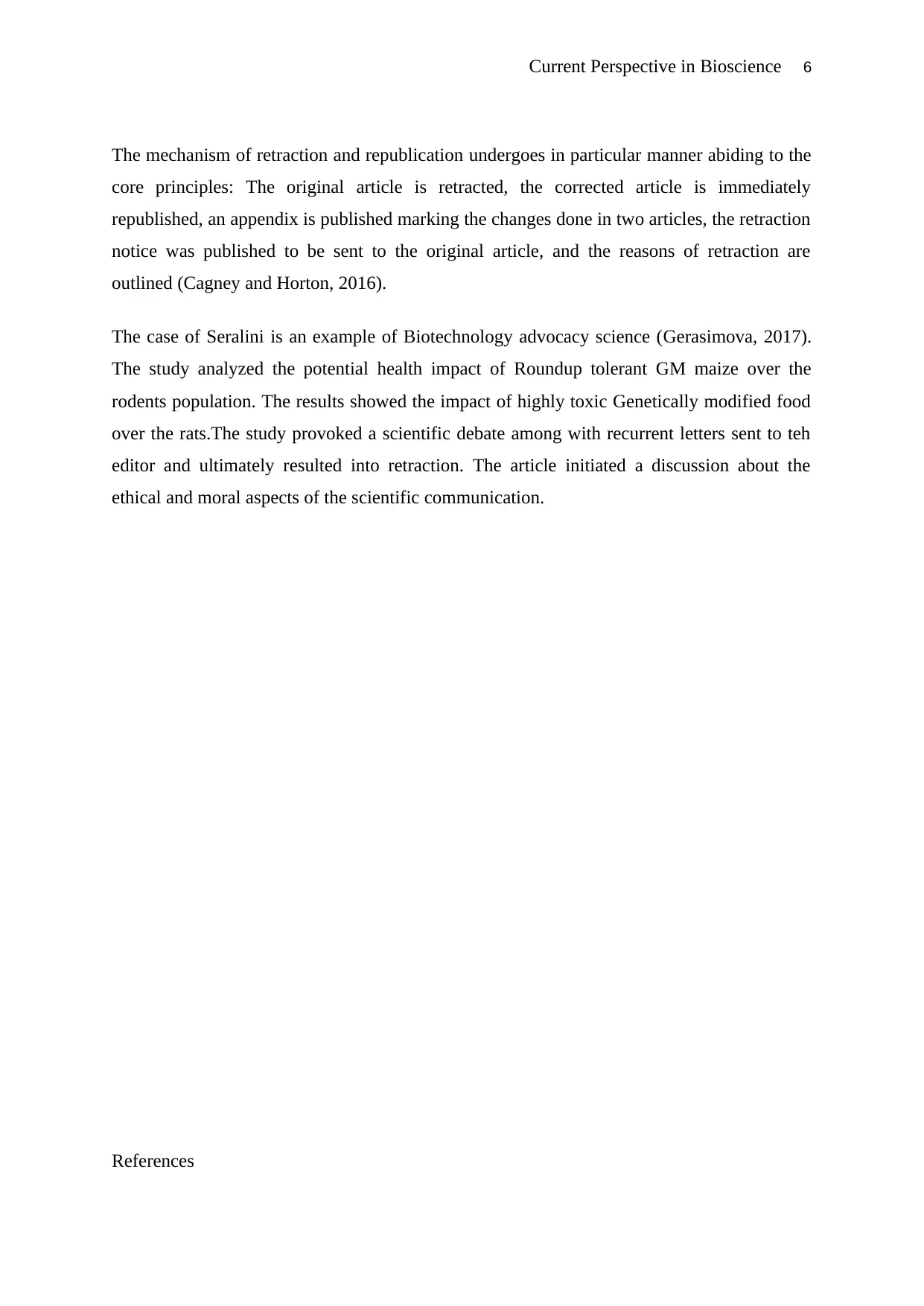
Current Perspective in Bioscience 6
The mechanism of retraction and republication undergoes in particular manner abiding to the
core principles: The original article is retracted, the corrected article is immediately
republished, an appendix is published marking the changes done in two articles, the retraction
notice was published to be sent to the original article, and the reasons of retraction are
outlined (Cagney and Horton, 2016).
The case of Seralini is an example of Biotechnology advocacy science (Gerasimova, 2017).
The study analyzed the potential health impact of Roundup tolerant GM maize over the
rodents population. The results showed the impact of highly toxic Genetically modified food
over the rats.The study provoked a scientific debate among with recurrent letters sent to teh
editor and ultimately resulted into retraction. The article initiated a discussion about the
ethical and moral aspects of the scientific communication.
References
The mechanism of retraction and republication undergoes in particular manner abiding to the
core principles: The original article is retracted, the corrected article is immediately
republished, an appendix is published marking the changes done in two articles, the retraction
notice was published to be sent to the original article, and the reasons of retraction are
outlined (Cagney and Horton, 2016).
The case of Seralini is an example of Biotechnology advocacy science (Gerasimova, 2017).
The study analyzed the potential health impact of Roundup tolerant GM maize over the
rodents population. The results showed the impact of highly toxic Genetically modified food
over the rats.The study provoked a scientific debate among with recurrent letters sent to teh
editor and ultimately resulted into retraction. The article initiated a discussion about the
ethical and moral aspects of the scientific communication.
References
You're viewing a preview
Unlock full access by subscribing today!
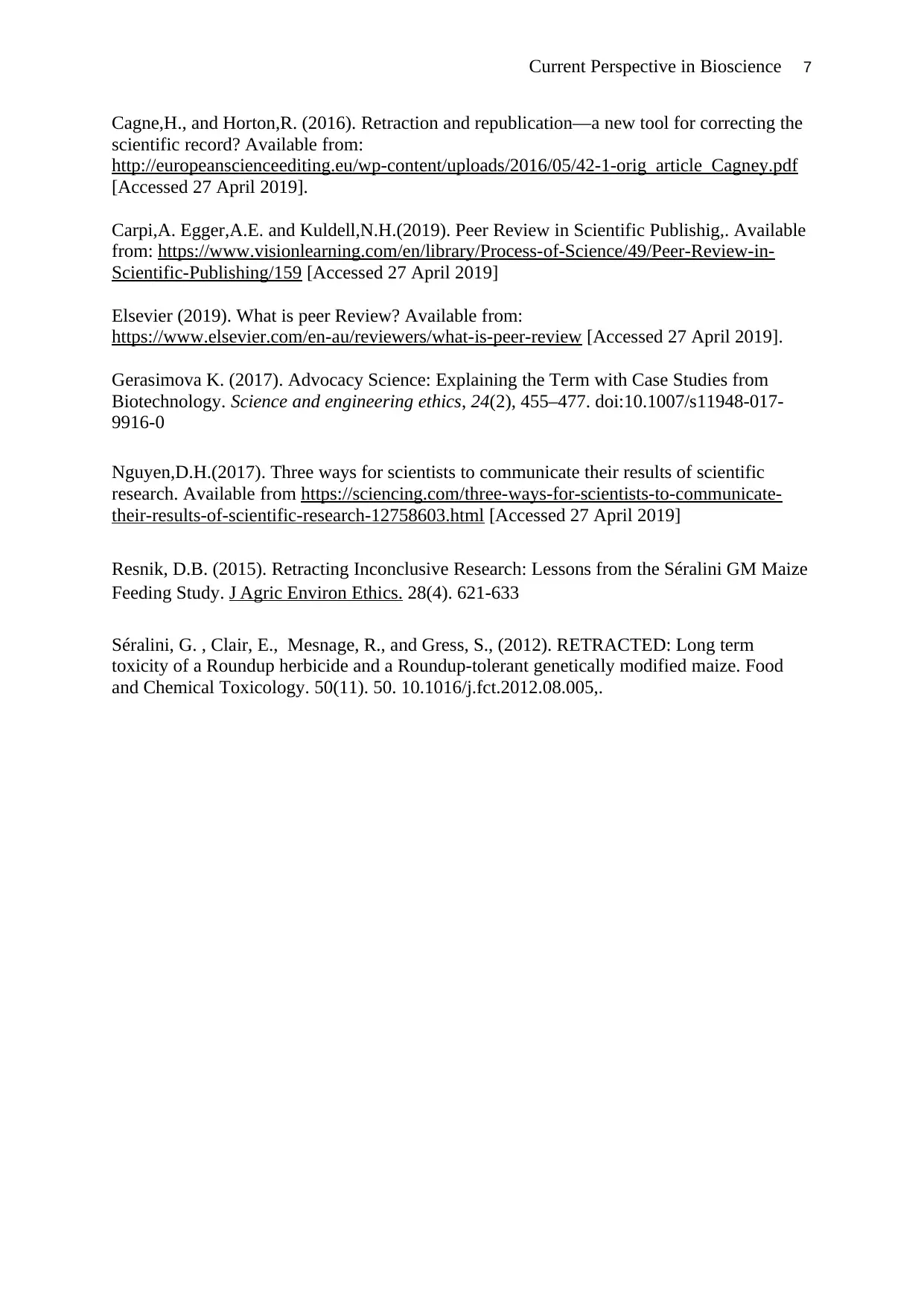
Current Perspective in Bioscience 7
Cagne,H., and Horton,R. (2016). Retraction and republication—a new tool for correcting the
scientific record? Available from:
http://europeanscienceediting.eu/wp-content/uploads/2016/05/42-1-orig_article_Cagney.pdf
[Accessed 27 April 2019].
Carpi,A. Egger,A.E. and Kuldell,N.H.(2019). Peer Review in Scientific Publishig,. Available
from: https://www.visionlearning.com/en/library/Process-of-Science/49/Peer-Review-in-
Scientific-Publishing/159 [Accessed 27 April 2019]
Elsevier (2019). What is peer Review? Available from:
https://www.elsevier.com/en-au/reviewers/what-is-peer-review [Accessed 27 April 2019].
Gerasimova K. (2017). Advocacy Science: Explaining the Term with Case Studies from
Biotechnology. Science and engineering ethics, 24(2), 455–477. doi:10.1007/s11948-017-
9916-0
Nguyen,D.H.(2017). Three ways for scientists to communicate their results of scientific
research. Available from https://sciencing.com/three-ways-for-scientists-to-communicate-
their-results-of-scientific-research-12758603.html [Accessed 27 April 2019]
Resnik, D.B. (2015). Retracting Inconclusive Research: Lessons from the Séralini GM Maize
Feeding Study. J Agric Environ Ethics. 28(4). 621-633
Séralini, G. , Clair, E., Mesnage, R., and Gress, S., (2012). RETRACTED: Long term
toxicity of a Roundup herbicide and a Roundup-tolerant genetically modified maize. Food
and Chemical Toxicology. 50(11). 50. 10.1016/j.fct.2012.08.005,.
Cagne,H., and Horton,R. (2016). Retraction and republication—a new tool for correcting the
scientific record? Available from:
http://europeanscienceediting.eu/wp-content/uploads/2016/05/42-1-orig_article_Cagney.pdf
[Accessed 27 April 2019].
Carpi,A. Egger,A.E. and Kuldell,N.H.(2019). Peer Review in Scientific Publishig,. Available
from: https://www.visionlearning.com/en/library/Process-of-Science/49/Peer-Review-in-
Scientific-Publishing/159 [Accessed 27 April 2019]
Elsevier (2019). What is peer Review? Available from:
https://www.elsevier.com/en-au/reviewers/what-is-peer-review [Accessed 27 April 2019].
Gerasimova K. (2017). Advocacy Science: Explaining the Term with Case Studies from
Biotechnology. Science and engineering ethics, 24(2), 455–477. doi:10.1007/s11948-017-
9916-0
Nguyen,D.H.(2017). Three ways for scientists to communicate their results of scientific
research. Available from https://sciencing.com/three-ways-for-scientists-to-communicate-
their-results-of-scientific-research-12758603.html [Accessed 27 April 2019]
Resnik, D.B. (2015). Retracting Inconclusive Research: Lessons from the Séralini GM Maize
Feeding Study. J Agric Environ Ethics. 28(4). 621-633
Séralini, G. , Clair, E., Mesnage, R., and Gress, S., (2012). RETRACTED: Long term
toxicity of a Roundup herbicide and a Roundup-tolerant genetically modified maize. Food
and Chemical Toxicology. 50(11). 50. 10.1016/j.fct.2012.08.005,.
1 out of 7
Your All-in-One AI-Powered Toolkit for Academic Success.
+13062052269
info@desklib.com
Available 24*7 on WhatsApp / Email
![[object Object]](/_next/static/media/star-bottom.7253800d.svg)
Unlock your academic potential
© 2024 | Zucol Services PVT LTD | All rights reserved.


